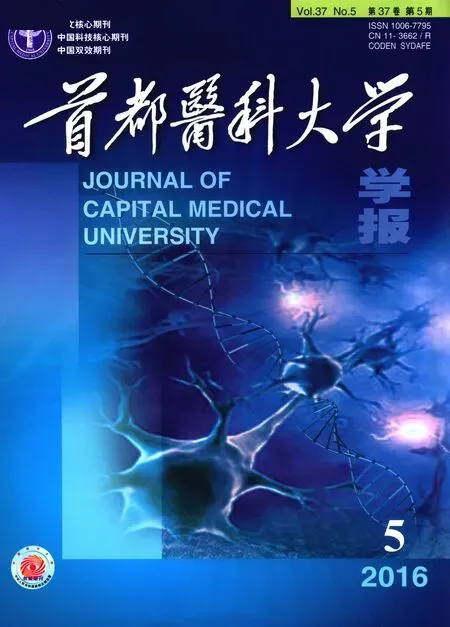塵螨變應原免疫治療聯合藥物治療對哮喘合并變應性鼻炎患兒臨床療效及氣道高反應性的影響
皇惠杰 劉曉穎 侯曉玲 苗 青 向 莉
(首都醫科大學附屬北京兒童醫院過敏反應科,北京 100045)
?
· 呼吸疾病基礎與臨床 ·
塵螨變應原免疫治療聯合藥物治療對哮喘合并變應性鼻炎患兒臨床療效及氣道高反應性的影響
皇惠杰劉曉穎侯曉玲苗青向莉*
(首都醫科大學附屬北京兒童醫院過敏反應科,北京 100045)
目的 了解哮喘合并變應性鼻炎患兒經塵螨變應原免疫治療聯合藥物治療后的臨床療效及對氣道高反應性的影響。方法選擇2012年2月至2012年11月就診于首都醫科大學附屬北京兒童醫院確診塵螨致敏的輕、中度哮喘合并變應性鼻炎患兒26例,采用病例自身對照研究,對其進行塵螨特異性免疫治療聯合哮喘及鼻炎藥物治療。結果26例患兒3年按期監測氣道反應性,患兒癥狀用藥計分(Symptom and Medication Score,SMS)由治療前的6.1±2.3顯著減低為1年時的3.3±1.5,2年時的2.2±1.6和3年時的1.1±1.3(P<0.05),自主哮喘控制評估(Children Asthma Control Test, C-ACT)由治療前的22.2±3.3顯著增高至1年時的24.7±2.6,并維持至2年時25.0±1.5和3年時的25.2±1.8(P<0.05),視覺模擬評分(Visual Analog Scale,VAS)哮喘癥狀由治療前的2.8±2.5顯著下降為治療1年時的1.1±1.7,2年時1.1±1.03和3年時的0.6±1.09(P<0.05),變應性鼻炎癥狀的VAS由治療前的4.7±2.0顯著下降為1年時的1.7±1.9, 2年時的1.9±1.7和3年時的1.2±1.3(P<0.05),而肺功能指標無明顯改善(P>0.05);氣道反應性特征中,氣道阻力由1年時的8.176±2.634下降為2年時的7.461±2.464和3年時的6.957±2.440(P<0.05);傳導率(respiratory conductance,Grs)由1年時的0.135±0.045升高為2年時的0.151±0.062和3年時的0.163±0.067(P<0.05),最小誘發累積劑量或反應閾值(minimum dose of bronchoconstrictor or the amount of the cumulative dose at the inflection point where the reciprocal of Rrs (Grs) decreases linearly, Dmin)由1年的7.110±10.865升高為2年時的9.558±9.487和3年時的19.640±12.379(P<0.05)。結論變應原免疫治療哮喘合并變應性鼻炎患兒的療效顯著,氣道反應性及氣道敏感性降低。
哮喘;變應性鼻炎;兒童;變應原免疫治療;氣道高反應性
支氣管哮喘和變應性鼻炎均是兒童常見的慢性氣道過敏性疾病。氣道高反應性(airway hyperreactivity,AHR)是哮喘的重要病理生理特征之一,氣道高反應性是指氣管和支氣管受輕微物理、化學、藥物、變應原等刺激后,氣道阻力明顯增大的現象。它是基于氣道變態反應性炎性反應的一種病理生理狀態[1]。支氣管激發試驗是用于測定氣道高反應性,從而協助哮喘診斷和了解治療效果的重要檢測方法。本研究采用病例自身對照研究,對哮喘合并變應性鼻炎的患兒行變應原免疫治療并長期規律隨訪,初步探討行變應原免疫治療患兒的氣道反應性特性。
1 研究對象與方法
1.1研究對象
選擇2012年2月至2012年11月就診于首都醫科大學附屬北京兒童醫院過敏反應科確診塵螨致敏的輕、中度哮喘合并變應性鼻炎患兒,診斷標準根據兒童支氣管哮喘診斷與防治指南[2]和兒童變應性鼻炎診斷和治療指南[3],根據患兒及其監護人意愿,選擇用舌下含服途徑的塵螨特異性免疫治療(sublingual immunotherapy, SLIT)和皮下注射途徑的塵螨特異性免疫治療(subcutaneous immunotherapy, SCIT)。規律隨訪并3年均監測氣道反應性26例,其中,男性17例,女性9例,SLIT 15例,SCIT 11例。本研究獲得首都醫科大學附屬北京兒童醫院倫理委員會批準,患兒監護人均簽署知情同意書。
1.2變應原免疫治療
SCIT應用標準化屋塵螨變應原提取液(丹麥ALK-Abello公司生產),皮下注射部位為上臂遠端[1/3]的外側,左右臂輪流注射;劑量上升期及劑量維持期治療方案參見文獻[4]。SLIT采用舌下含服粉塵螨滴劑(浙江我武生物科技股份有限公司生產),劑量上升期及劑量維持期治療方案參見文獻[5]。
1.3藥物治療
根據2008年兒童支氣管哮喘診斷與防治指南[2]和變應性鼻炎診斷和治療指南[3]對患兒進行疾病分級和分度,定期再評估并調整治療方案。
1.4肺功能測定
采用MasterScreen型肺功能儀(德國Jaeger公司生產),應用最大呼氣流量-容積曲線 (Maximal expiratory flow-volume curve, MEFV) 測定6歲以上患兒的肺通氣功能,測定參數包括測定用力肺活量(percentage of forced vital capacity to predicted values, FVC%pred)、第1秒用力呼氣容積占預計值的百分比(percentage of forced expiratory volume in one second to predicted values, FEV1%pred)、第1秒用力呼氣容積占用力肺活量百分比 (FEV1/FVC)、最大用力呼氣峰流量占預計值的百分比(percentage of peak expiratory flow to predicted values, PEF%pred)、用力呼出25%、50%、75%肺活量時的瞬間呼氣流量占預計值的百分比(percentage of forced expiratory flow at 75%、50%、25%vital capacity to predicted values, FEF25%pred、FEF50%pred、FEF75%pred)、最大呼氣中段流量占預計值的百分比 (percentage of maximum midexpiratory flow to predicted values, MMEF%pred)[6]。
1.5氣道高反應性測定
采用Astograph J-21氣道反應性測定儀(Chest公司,日本);乙酰甲膽堿(methacholine chloride,Mch;Sigma公司,美國),0.9%(質量分數)氯化鈉注射液2 mg:2.5 mL沙丁胺醇霧化溶液及250 μg:2 mL異丙托溴銨霧化溶液。兒童測試時選擇振蕩頻率7Hz。主要技術指標:基礎呼吸阻力(controlled respiratory resistance,Rrs cont)、傳導率(respiratory conductance,Grs)、最小誘發累積劑量或反應閾值(minimum dose of bronchoconstrictor or the amount of the cumulative dose at the inflection point where the reciprocal of Rrs (Grs) decreases linearly, Dmin)、傳導率下降斜率(Linear slope of the Grs decreased, sGrs)、使Rrs升高到基礎水平的135%所需乙酰甲膽堿累積劑量(cumulative provocative dose that causes a 135% increase in Rrs cont,PD35),其中Dmin和PD35反映氣道敏感性。氣道阻力開始上升時的乙酰甲膽堿濃度記為Cmin(minimum concentration at the point where the resistance starts to increase, Cmin),Cmin為49、98、195 μg/mL時氣道高反應性重度,Cmin為391、781、1 563、3 125 μg/mL時氣道高反應性中度,Cmin為 6 250、12 500、25 000 μg/mL時氣道高反應性輕度。
1.6臨床癥狀評價指標
1.6.1哮喘癥狀計分
哮喘癥狀包括咳嗽/咳痰、喘息、胸悶、憋氣以及夜間因哮喘癥狀憋醒。根據癥狀嚴重程度不同計為0、1、2、3分[7]。
1.6.2鼻炎癥狀計分
鼻炎癥狀包括噴嚏、流涕、鼻塞和鼻癢。根據癥狀嚴重程度不同計為0、1、2、3分[8]。
1.6.3哮喘及鼻炎治療藥物計分
藥物評分標準參照世界變態反應組織工作組文件關于特異性免疫治療的臨床推薦意見以及中華耳鼻咽喉頭頸外科學分會鼻科學組制定的免疫治療評分標準[9-10]。
1.6.4哮喘及鼻炎癥狀用藥及評分(Symptom and Medication Score, SMS)
哮喘及鼻炎SMS=平均每日哮喘癥狀計分+平均每日鼻炎癥狀計分+平均每日哮喘用藥計分+平均每日鼻炎用藥計分。
1.6.5哮喘控制測試
哮喘控制測試包括12歲以上哮喘患兒的哮喘控制測試(Asthma Control Test,ACT)和12歲以下哮喘患兒的兒童哮喘控制測試(Children Asthma Control Test,C-ACT),用于自主評估近1個月哮喘控制狀態[11]。
1.6.6視覺模擬評分(Visual Analog Scale, VAS)
VAS可以將疾病的嚴重度量化為0~10分,0分為無癥狀,10分為癥狀最嚴重,用于自我評估近1個月哮喘或鼻炎癥狀的嚴重度[12]。
1.7統計學方法

2 結果
2.1臨床療效分析
治療1、2、3年時,患兒的癥狀用藥計分(SMS)較治療前均顯著降低,ACT評分均顯著升高,哮喘和鼻炎癥狀的VAS評分亦均顯著降低,而且治療3年時的SMS較治療2年和1年時及治療2年較1年時,仍有持續顯著的減低(P<0.05),詳見表1;肺功能各指標均較治療前差異無統計學意義(P>0.05),詳見表2。

表1 患兒各時點的臨床指標

表2 患兒各時點的肺功能指標
2.2氣道反應性特征
治療1年時,乙酰甲膽堿支氣管激發試驗20例,陽性率76.9%;2年時陽性16例,陽性率61.5%; 3年時陽性18例,陽性率69.2%;采用配對χ2檢驗,比較不同時點的氣道反應性結果頻數分布,差異無統計學意義(P>0.05),即治療1、2、3年時陽性率比較,差異無統計學意義,詳見表3。
治療3年時,Rrs、Grs、Cmin較治療1年時差異有統計學意義(P<0.05),Dmin治療3年較1年及2年時差異均有統計學意義(P<0.05),詳見表4。

表3 不同時點氣道反應性結果樣本的頻數分布

表4 不同時點的氣道反應性特征
n=26;*P<0.05vsone year;#P<0.05vstwo years;Rrs: respiratory resistance; Grs: respiratory conductance; Dmin: minimum dose of bronchoconstrictor. Or the amount of the cumulative dose at the inflection point where the reciprocal of Rrs (Grs) decreases linearly; Cmin: minimum concentration at the point where the resistance starts to increase; sGrs: linear slope of the Grs decreased; PD35: cumulative provocative dose that causes a 135% increase in Rrs cont.
3 討論
2007年,世界變態反應組織(World Allergy Organization, WAO)關于變應原免疫治療的臨床應用指導文件[9]中,推薦在評估SIT療效的臨床研究中主要終點指標為癥狀用藥計分,本研究依據WHO相關文件指導意見,以哮喘鼻炎聯合SMS為主要療效評價指標,SMS較治療前顯著下降(P<0.05),與國內外報道[13-14]的變應原免疫治療對兒童和成人哮喘及變應性鼻炎的療效評估相一致。
本研究對患兒肺功能的評估表明,各指標均較治療前無明顯改善。中國臺灣地區一項納入145例塵螨致敏的輕中度持續哮喘的患兒進行了為期1年的雙盲安慰劑研究[15]顯示,舌下免疫治療組FVC%pred、FEV1%pred和PEF均較治療前增高;向莉等[16]分析SCIT對于哮喘患兒的臨床療效的研究顯示:SCIT聯合哮喘藥物治療組同單純哮喘藥物治療組患兒的肺功能相比無明顯變化,本研究中肺功能指標在治療前后無明顯變化,可能由于患兒病情為輕中度,免疫治療前病情已趨于緩解,因而肺功能大多無明顯變化。
采用Astograph法檢測氣道反應性,該法只需潮氣呼吸,可自動切換增加吸入藥物濃度并連續檢測并快速檢測劑量-反應曲線,試驗較安全,操作過程簡單,尤其更適合兒童及老年人。26例患兒在檢測過程中均無明顯不適。本研究顯示,3年時Rrs、Grs、Cmin較1年時有顯著改善,Dmin治療3年較1年、2年均有顯著改善。目前對成人哮喘患者采用Astogragh法測定氣道高反應性的研究相對較多,黃克武等[17]的研究中56例15~74歲哮喘患者的支氣管激發試驗陽性率為92.9%,曹璐等[18]同樣采用Astogragh法對80例13~58歲的哮喘患者行激發試驗,結果為100%的患者激發試驗陽性。以上研究支氣管激發試驗陽性率均高于本研究,考慮與患者群年齡相關,同時考慮可能受到患者的哮喘控制狀態的影響,本研究中患兒均為規律治療后處于控制或部分控制狀態,可能導致激發試驗陽性率稍低。殷菊等[19]曾對緩解期哮喘患兒的支氣管反應性進行研究,發現緩解期哮喘患兒的支氣管激發試驗陽性率為72%(28/39),而袁竹青等[20]以成人為研究對象,對完全控制的支氣管哮喘成人患者和初診處于癥狀期的哮喘成人患者行氣道高反應性測定,結果為完全控制組的支氣管激發試驗陽性率為84.5%(49/58),初診有癥狀的哮喘組患者的支氣管激發試驗陽性率為100%,提示哮喘的控制狀態可能影響支氣管激發試驗的陽性率。
目前對兒童哮喘患者的氣道高反應性多為橫斷面特征性探討,萬莉雅[21]曾比較兒童支氣管哮喘、咳嗽變異性哮喘(cough variant asthma, CVA)和支氣管炎等不同呼吸系統疾病氣道反應性的特點,得出哮喘、CVA和支氣管炎等不同呼吸系統疾病患兒的氣道反應性及氣道敏感性均高于健康兒童,而不同呼吸系統疾病患兒的氣道反應性、氣道敏感性變化也各不相同。但目前對規律治療并隨訪的哮喘患兒的氣道高反應性的變化的研究較少涉及[22-23]。本研究中26例患兒均規律隨訪且進行變應原免疫治療聯合藥物治療3年,監測其氣道高反應性,氣道基礎阻力、Grs、Cmin、Dmin均顯著改善,可見3年的治療可改善患兒的氣道高反應性。但有1例患兒的支氣管激發試驗由治療1年時的陰性轉為治療2年時的陽性(輕度),有2例患兒由治療2年時的陰性轉為陽性;可見氣道高反應性存在一定的波動性。因此定期監測有一定的預示價值。這也是慢性病長期規律治療及監測的必要性所在。
目前Astograph法不是監測氣道反應性的主流方法,不易與其他方法的劑量比較,現支氣管激發試驗多局限于具備專業知識和經驗的研究中心使用,所以仍應繼續尋求簡便易行的適用于兒童群體的支氣管激發試驗,讓更多的醫者關注哮喘患兒氣道高反應性的同時,加強患兒及看護者的教育,控制狀態良好的哮喘患兒氣道高反應性可能改善。
[1]張靜,朱蕾.氣道高反應性的解讀[J].中華結核和呼吸雜志,2015,38(8):634.
[2]中華醫學會兒科學會呼吸學組,《中華兒科雜志》編輯委員會.兒童支氣管哮喘診斷與防治指南[J].中華兒科雜志,2008,46(10):745-753.
[3]中華耳鼻咽喉頭頸外科雜志編輯委員會鼻科組,中華醫學會耳鼻咽喉頭頸外科學分會鼻科學組、小兒學組,中華兒科雜志編輯委員會等.兒童變應性鼻炎診斷和治療指南(2010年,重慶)[J].中華耳鼻咽喉頭頸外科雜志,2011,46(1):7-8.
[4]Blumberga G, Groes L, Dahl R. SQ-standardized house dust mite immunotherapy as an immunomodulatory treatment in patients with asthma[J]. Allergy, 2011, 66(2): 178-185.
[5]陳伯亞,龍自銘,黃燕君,等.舌下含服粉塵螨滴劑治療單一和多重過敏變應性鼻炎患者的臨床療效評估[J].中華耳鼻咽喉頭頸外科雜志,2013,48(7):549-554.
[6]中華醫學會呼吸病學分會肺功能專業組.肺功能檢查指南(第二部分)——肺量計檢查[J].中華結核和呼吸雜志,2014,37(7):481-486.
[7]Yukselen A, Kendirli S G, Yilmaz M, et al. Effect of one-year subcutaneous and sublingual immunotherapy on clinical and laboratory parameters in children with rhinitis and asthma: a randomized, placebo-controlled, double-blind, double-dummy study[J]. Int Arch Allergy Immunol,2012,157(3):288-298.
[8]Yukselen A, Kendirli S G, Yilmaz M, et al.Two year follow-up of clinical and inflammation parameters in children monosensitized to mites undergoing subcutaneous and sublingual immunotherapy[J].Asian Pac J Allergy Immunol,2013,31(3):233-241.
[9]Canonica G W, Baena-Cagnani C E,Bousquet J, et al.Recommendations for standardization of clinical trials with allergen specific immunothempy for respiratory allergy. a statement of a world allergy organization (WAO) taskforee[J].Allergy, 2007,62(3):317-324.
[10]中華耳鼻咽喉頭頸外科雜志編委會鼻科組,中華醫學會耳鼻咽喉頭頸外科學分會鼻科學組.變應性鼻炎特異性免疫治療專家共識[J].中華耳鼻咽喉頭頸外科雜志,2011,46(12):976-980.
[11]Voorend-Van Bergen S, Vaessen-Verberne A A, Landstra A M, et al. Monitoring childhood asthma: Web-based diaries and the asthma control test[J]. J Allergy Clin Immunol, 2014,133(6):1599-1605.e2.
[12]Demoly P, Bousquet P J, Mesbah K, et al.Visual analogue scale in patients treated for allergic rhinitis: an observational prospective study in primary care: asthma and rhinitis[J]. Clin Exp Allergy,2013,43(8):881-888.
[13]陳實,曾霞,王靈.不同療程舌下含服粉塵螨滴劑治療螨過敏變應性鼻炎伴哮喘患兒的療效觀察[J].中華耳鼻喉頭頸外科雜志,2015:50(8):627-631.
[14]Yukselen A,Kendirli SG. Role of immunotherapy in the treatment of allergic asthma[J]. World J Clin Cases, 2014,2(12):859-865.
[15]Niu C K, Chen W Y, Huang J L, et al. Efficacy of sublingual immunotherapy with high-dose mite extracts in asthma: multi-center, double-blind, randomized, and placebo-controlled study in Taiwan[J]. Respir Med, 2006,100(8):1374-1383.
[16]馮暉,向莉,申昆玲,等.屋塵螨皮下特異性免疫治療的哮喘患兒肺功能及免疫學動態變化[J].中國當代兒科雜志,2010,12(9):715-719.
[17]張恩花,潘娜,彭晶晶,等.評價Astograph乙酰甲膽堿激發試驗對支氣管哮喘的診斷價值[J].首都醫科大學學報,2010,31(5):531-535.
[18]曹璐,陳一冰,郝峰英,等.Astograph法支氣管激發試驗對哮喘診斷價值的研究[J].臨床肺科雜志,2012,17(4):583-585.
[19]殷菊,申昆玲,劉世英,等.緩解期哮喘患兒的支氣管反應性與小氣道功能的關系[J].中華兒科雜志,2004,42(2):87-89.
[20]袁竹青,胡蘇萍,聶漢祥,等.完全控制的支氣管哮喘患者肺功能和氣道高反應性測定[J].臨床肺科雜志,2010,15(1):36-37.
[21]萬莉雅,張琴,任立歆,等.兒童不同呼吸系統疾病氣道反應性特點及其臨床價值[J].臨床兒科雜志,2012,30(8):734-738.
[22]周靜,于鐵英,董有靜. 七氟烷對卵白蛋白致敏的高反應氣道肺阻力的影響[J]. 中國醫科大學學報,2014,43(10) :889-891.
[23]李凡敏,梁宗安,胡麗佳,等. 慢性阻塞性肺疾病和支氣管哮喘吸入布地奈德/福莫特羅的肺功能變化趨勢研究[J]. 中國煤炭工業醫學雜志,2015,18(9) :1494-1496.
編輯陳瑞芳
, E-mail:drxiangli@163.com
Effects of dust mite allergy immunotherapy on clinical efficacy and airway hyperresponsiveness in allergic asthma and rhinitis children sensitized to dust mite
Huang Huijie, Liu Xiaoying, Hou Xiaoling, Miao Qing, Xiang Li*
(DepartmentofAllergy,BeijingChildren’sHospital,CapitalMedicalUniversity,Beijing100045,China)
ObjectiveTo understand the clinical efficacy in children with asthma and allergic rhinitis who received the dust mite allergy immunotherapy(AIT), and to discuss the influence of dust mite allergy immunotherapy on airway hyperresponsiveness. MethodsA total of 26 cases with mild or moderate persistent asthma complicated with allergic rhinitis who received the dust mite specific immunotherapy combined with drug therapy between February 2012 and November 2012 in Beijing Children’s Hospital were enrolled in the case-self-control study. ResultsTotally 26 cases completed treatment for three years and monitoring airway hyperresponsiveness. The average daily Symptom and Medication Score (SMS) at one, two and three years after the dust mite allergy immunotherapy were 3.3±1.5, 2.2±1.6,1.1±1.3 respectively, which were significantly lower than at the baseline values (6.1±2.3) (P<0.05), ACT/C-ACT assessment at one, two and three years after AIT were 24.7±2.6, 25.0±1.5, 25.2±1.8 respectively, which were higher than that at the baseline (22.2±3.3) (P<0.05); Asthma Visual Analog Scale (VAS) at one, two and three years after AIT were 1.1±1.7, 1.1±1.03, 0.6±1.09 respectively, which were significantly lower than that at the baseline (2.8±2.5) (P<0.05). Allergic rhinitis VAS score at one and two and three year after AIT were 1.7±1.9, 1.9±1.7, 1.2±1.3 respectively, which were significantly lower than at the baseline (4.7±2.0) (P<0.05). However, the pulmonary function index was not significantly different after the treatment. Respiratory resistance (RrS) at two and three year after AIT were 7.461±2.464, 6.957±2.440, which were significantly lower than at one year(8.176±2.634)(P<0.05); Respiratory conductance (Grs) at two and three year after AIT were 0.151±0.062, 0.163±0.067, which were higher than that at one year (0.135±0.045) (P<0.05); Minimum dose of bronchoconstrictor or the amount of the cumulative dose at the inflection point where the reciprocal of Rrs (Grs) decreases linearly (Dmin) at two and three year after AIT were 9.558±9.487, 19.640±12.379, which were higher than that at one year (7.110±10.865) (P<0.05). ConclusionThe dust mite allergy immunotherapy could improve symptoms significantly, reduced asthma controller medication, improved airway hyperresponsiveness but did not significantly improve the spirometric parameters.
asthma; allergic rhinitis; children; allergy immunotherapy; airway hyperresponsiveness
首都臨床特色應用研究(Z151100004015030),北京市科技專項(Z131100006813044)。This study was supported by Capital Characteristic Clinical Application(Z151100004015030), Beijing Programs for Science and Technology(Z131100006813044).
時間:2016-07-0011∶00
http://www.cnki.net/kcms/detail/11.3662.R.20161016.1100.044.html
10.3969/j.issn.1006-7795.2016.05.002]
R 562.2+5;R 765.21
2016-06-30)

